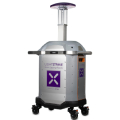Introduction
The current global pandemic has made us all more aware of the impact germs have on our daily lives, and how we often unknowingly help spread those tiny living organisms from place to place. Whether you’re at home, work, shopping at one of your favorite stores, or pretty much anywhere for that matter, there’s a good chance there are germs lurking on commonly touched surfaces — waiting for a chance to hitch a ride. As we approach World MRSA Day, let’s take a moment to explore a brief history of the superbug, the impact on hospitals and communities, and how you can stay healthy while helping to prevent spread.
Background
Staphylococcus aureus (S. aureus) is a common bacteria found inside the nose of about 30% of people. These people are typically asymptomatic, unknowingly shedding the opportunistic bacteria into the environment where more vulnerable persons contract infections. Though most commonly associated with skin and soft tissue infection, often referred to as staph infections, infections can affect the blood, respiratory system, and more. A course of antibiotics is the required treatment; however, this clever bacteria prevents that from being simple.
In the 1940’s and 1950’s, S. aureus was identified as being resistant to several different drug classes. In 1961, Methicillin Resistant Staphylococcus Aureus (MRSA) emerged as a life-threatening hospital acquired infection. Today these infections still pose severe complications, as the bacteria is multi-drug resistant and adapts resistance patterns as it is exposed to new antibiotics. So what does that mean and why do we care? We often talk about “fighting” germs with antibiotics, so let’s expand on that analogy a little bit. Each antibiotic has a slightly different fighting move. MRSA quickly learns those moves, builds the perfect protective shield, making those fighting moves useless- and each time we use those moves MRSA gets better at defeating them. It truly is a superbug!
MRSA in Hospitals
As a result of the high level of antimicrobial use, MRSA has been able to thrive in hospitals. Evidence of transmission has been traced from patients to healthcare workers to other patients. Even the environment serves as a source of transmission when not properly cleaned and disinfected. Insufficient hand hygiene and improper use of personal protective equipment (PPE), such as gloves, also contribute to higher rates of contamination. Studies have found that transmission of MRSA occurs in approximately 17% of contact between healthcare workers and known MRSA patients. While healthcare workers are found to have a 75% or higher compliance rate when it comes to wearing gloves, doctors fall extremely short with about 27% compliance rate. Hand hygiene is essential for reducing the spread of infectious diseases in the environment, especially in high risk areas like hospitals. However, studies show compliance after touching surrounding areas was only 50% and before touching a patient was 63%. With many germs transferred through contact, and only 60% of surfaces disinfected after manual cleaning alone, potential for spreading those germs remain high.
MRSA in the Community
Patients are not the only ones who should be concerned with the disinfection practices of area hospitals. In the late 1990s, MRSA emerged as a growing threat in communities. A study was conducted involving healthcare workers and their families. The study found that 47% of family members contracted MRSA from the MRSA positive healthcare worker. Those family members then spread the infection to 67% of their household members. It stands to reason that the more people in a household and the closer those relationships, the greater the exposure risk. This seems to have been confirmed in a 6 year long study of selected family units, where 43% of families contracted MRSA and 25% of people who had contact with those families also contracted MRSA. The study also found that 70% of those infected had close relationships, such as adult couples, parents and children, and siblings. Interestingly, none of the people in this study had any hospital exposure- no family members worked in hospitals, no one was admitted. In this study, the MRSA was acquired completely within the community.
Risk & Mitigation
Although low levels of antimicrobial use are typically found in communities, the ability to spread so easily and strong resistance to multiple antibiotics allows for MRSA to flourish outside of hospitals. While the bacteria prefers to call the nose home, it is also found inside the cheeks, on the hands, the underarms, the umbilicus, and the groin area. Skin to skin contact remains one of the highest modes of transmission, but risk is associated with environmental factors as well. Public transit, university dormitories, military barracks, locker rooms, jails and prisons, and other communal areas shared by otherwise healthy individuals present greater risk for contracting MRSA.
While 70-80% of infections are skin and soft tissue some individuals do develop secondary infections, which may be life threatening. Mortality rates associated with secondary infections, like systemic blood infections, are 10% for community acquired MRSA and 15% for hospital acquired MRSA. Rates of MRSA infection increase during flu seasons, and co-infection with the flu increases the potential for contracting pneumonia. The mortality rate for this particular complication is severe, at 30%, and has contributed to both the American Thoracic Society and the Infectious Diseases Society of America to regard community acquired MRSA with outbreaks of pneumonia, SARS, and/or novel influenzas to be treated as life threatening.
With the current SARS-CoV-2 global pandemic and the influenza season just starting, it is critical that both individuals in the community and healthcare workers take precautions to prevent the spread of highly adaptable, opportunistic germs like MRSA. Practicing and promoting adequate hand hygiene is fundamental in both hospital and community settings. Hospitals can also adopt patient screening and decolonization policies, implement a policy of controlled antibiotic use, and promote antibiotic stewardship. Within the community, screening and decolonization practices can be adopted in appropriate settings, for example military recruits entering basic training, newly incarcerated persons, and students moving into dormitories. Additionally, community members can improve general hygiene and cleaning practices in both private and public spaces, and can promote antibiotic stewardship by completing courses of prescribed antibiotics, not sharing antibiotics, and properly disposing of any unused antimicrobials.
Conclusion
I could spend hours talking about this superbug, but that would be overkill- pun only slightly intended. If you weren’t already sold on the importance of washing your hands hands, hopefully you have been swayed. Next time you visit your doctor and are annoyed to be leaving without an antibiotic, think back to your little nose buddy MRSA and how quickly certain germs learn to become resistant to new antibiotics. Also don’t be afraid to remind your doctor and other healthcare providers to wash their hands and put on gloves! Germs don’t acknowledge boundaries, and it is the responsibility of everyone to prevent the spread of harmful germs like MRSA.
If you would like information on how LightStrike™ by Xenex works to disinfect the environment and deactivate germs like MRSA, please contact info@xenex.com
Amanda Berard, MS,. Healthcare Clinical Researcher, Xenex Disinfection Services
Sources
Carling, P.C., et al. “Identifying Opportunities to Enhance Environmental Cleaning in 23 Acute Care Hospitals.” Infection Control and Hospital Epidemiology. 29,1. (2008):1-7.
Carling, P. “Methods for assessing the adequacy of practice and improving room disinfection.” American Journal of Infection Control. 41. (2013):S20-S25.
Chalfine, A., Kitzis, M., Bezie, Y. et al. “Ten-year decrease of acquired methicillin-resistant Staphylococcus aureus (MRSA) bacteremia at a single institution: the result of a multifaceted program combining cross-transmission prevention and antimicrobial stewardship”. Antimicrob Resist Infect Control. 1,18. (2012).
Chavali, Siddharth et al. “Hand hygiene compliance among healthcare workers in an accredited tertiary care hospital.” Indian journal of critical care medicine : peer-reviewed, official publication of Indian Society of Critical Care Medicine. 18,10. (2014): 689-93.
Coll, F. et al. “Longitudinal genomic and epidemiological surveillance of methicillin-resistant Staphylococcus aureus in the UK reveals extensive transmission in hospitals and the community.” ScienceTranslational Medicine. 9, 413. (2017).
Eveillard, Matthieu, et al. “Carriage of Methicillin-Resistant Staphylococcus Aureus Among Hospital Employees: Prevalence, Duration, and Transmission to Households.” Infection Control & Hospital Epidemiology. 25, 2. (2004):114–120.
Huijsdens, X. W., et al. “Multiple Cases of Familial Transmission of Community-Acquired Methicillin-Resistant Staphylococcus aureus.” Journal of Clinical Microbiology. 44, 8. (2006): 2994-2996.
Johansson J.P. H., et al. “High prevalence of MRSA in household contacts.” Scandinavian Journal of Infectious Diseases. 39,9. (2007): 764-768.
McBryde, E.S., et al. “An investigation of contact transmission of methicillin-resistant Staphylococcus aureus.” Journal of Hospital Infection. 58, 2. (2004):104-108.
Mollema, F.P.N., et al. “Transmission of Methicillin-Resistant Staphylococcus aureus to Household Contacts.” Journal of Microbiology. 1, 48. (2010):202-207.
Murphy, C.R., et al. “Nursing home characteristics associated with methicillin-resistant Staphylococcus aureus (MRSA) Burden and Transmission”. BMC Infect Dis. 12, 269. (2012).
Skov R., et al. “Update on the prevention and control of community-acquired
meticillin-resistant Staphylococcus aureus (CA-MRSA)”. International Journal of Antimicrobial Agents. 39, 3. (2012):193-200.
Yamamoto, T., et al. “Community-acquired methicillin-resistant Staphylococcus aureus: community transmission, pathogenesis, and drug resistance.” Journal of Infection and Chemotherapy. 16. (2010): 225–254.

















